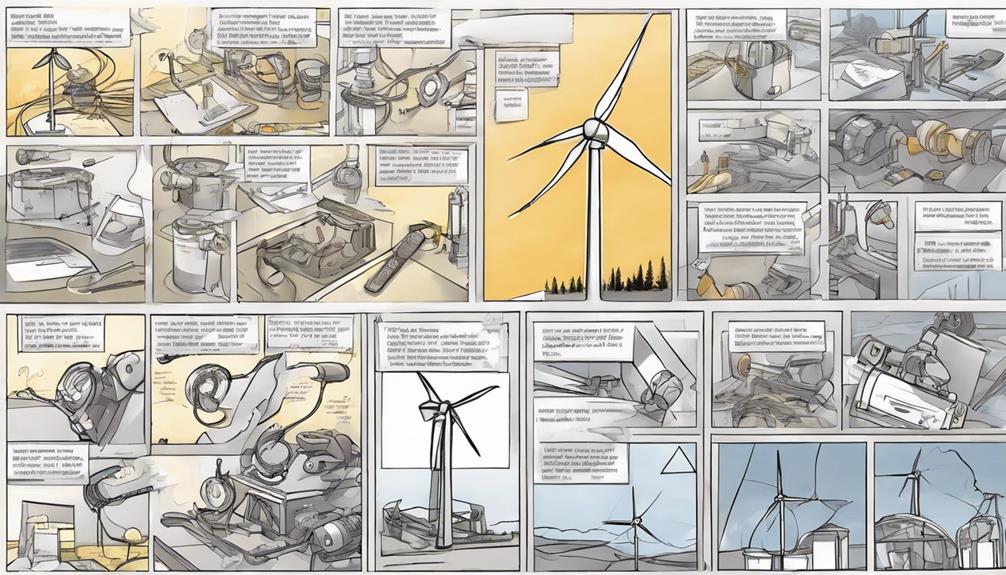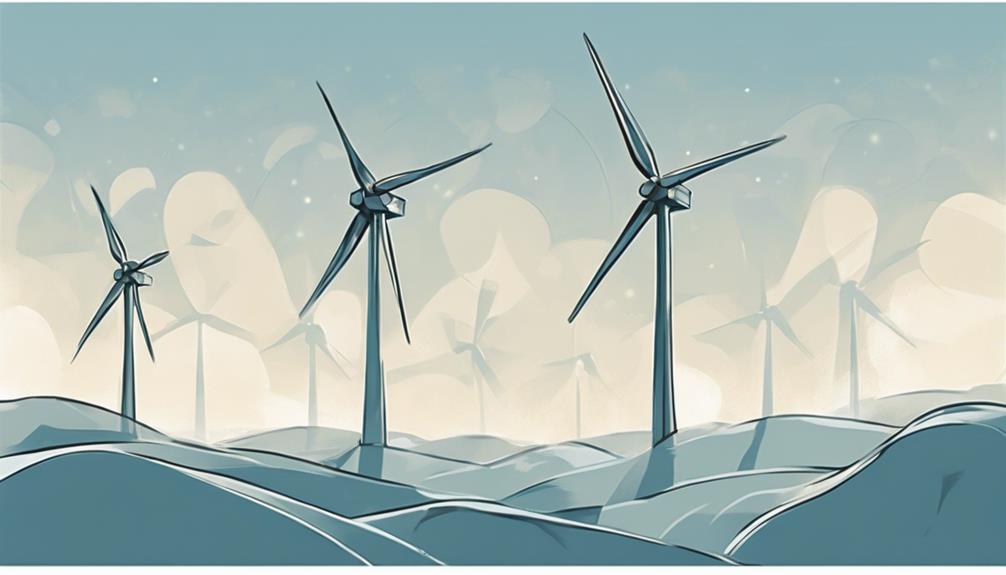To connect a wind turbine to your solar system, make sure your hybrid inverter is compatible for a smooth integration. Connect the wind generator to the hybrid inverter carefully to optimize power usage. Monitor your battery state of charge diligently and seek expert advice for the right controller. Link the inverter to your battery bank securely and follow manufacturer's guidelines for maintenance. Balance power output from wind and solar efficiently to enhance your system's performance. For more tips on maximizing energy production and increasing system reliability, explore further into optimizing system performance and securing efficient energy storage.
Key Takeaways
- Ensure hybrid inverter compatibility for seamless wind-solar integration.
- Select appropriate controller for efficient power management and monitoring.
- Connect wind generator to hybrid inverter using proper wiring.
- Balance energy inputs with a hybrid charge controller.
- Optimize power output by combining wind turbine and solar panels.
Compatibility of Hybrid Inverter for Integration
To integrate a wind turbine into your solar system successfully, confirm compatibility of the hybrid inverter for efficient energy storage.
Hybrid inverters play an integral role in harmonizing the energy output from both wind turbines and solar panels. Selectronic inverters, a popular choice for this purpose, enable seamless integration of these renewable energy sources with batteries. Ensuring compatibility between the hybrid inverter and the type of battery used is essential to optimize energy storage in your system.
Powerplus Energy batteries are frequently recommended due to their reliability and performance when paired with hybrid inverters in wind-solar setups. Additionally, selecting the right controller is vital as it facilitates the effective monitoring and management of power derived from both wind and solar sources.
Connecting Wind Generator to Hybrid Inverter
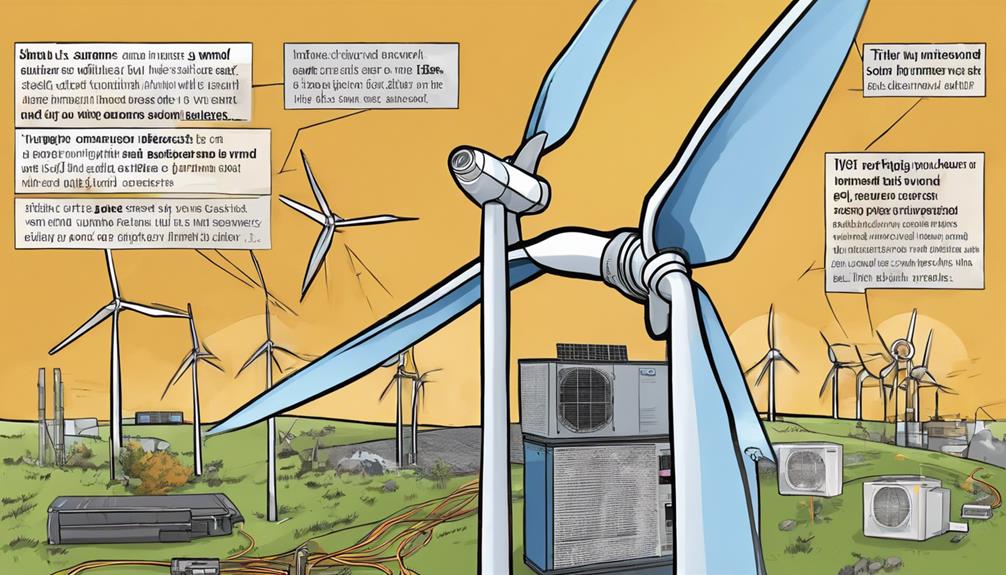
When connecting a wind generator to a hybrid inverter, prioritize guaranteeing seamless integration for efficient energy utilization. Wind turbines need a hybrid inverter to effectively add a wind generator to your existing solar system.
Hybrid inverters, such as Selectronic models, are designed to manage both wind and solar power inputs seamlessly, enhancing overall system performance. To store the energy generated from these sources, consider using Powerplus Energy batteries which are recommended for their reliability and efficiency.
It is important to monitor the battery state of charge and power usage diligently when connecting a wind generator to a hybrid inverter. This helps in maintaining ideal energy levels and preventing any potential overload situations.
Additionally, seeking expert advice on selecting the right controller for your specific battery type is essential for a successful integration of a wind generator into your solar system. By following these steps, you can achieve a smooth and effective connection between your wind generator and hybrid inverter, maximizing the benefits of renewable energy sources.
Managing Power Output Efficiently
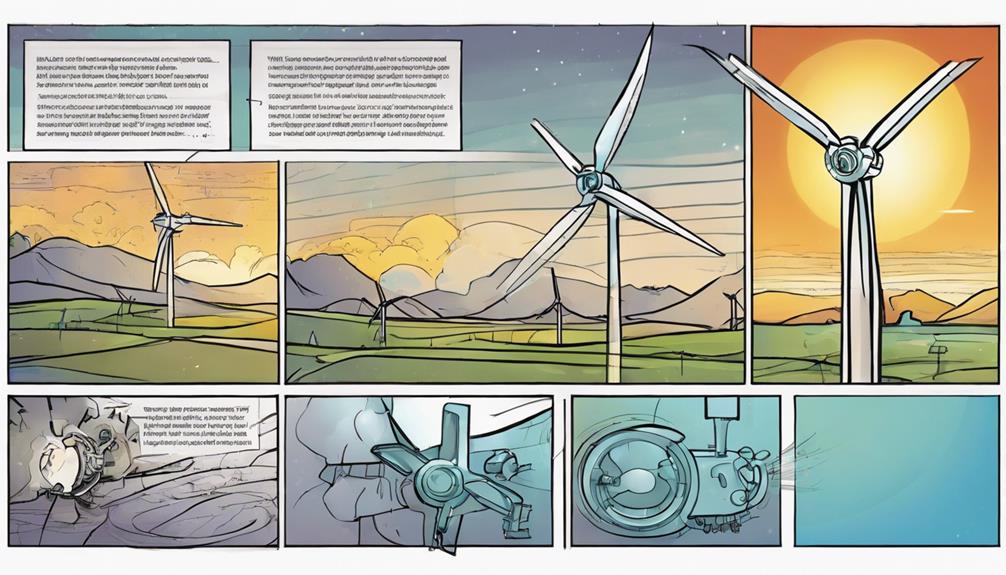
Effectively managing power output from wind turbines and solar panels requires the use of a hybrid charge controller. This vital component enables you to efficiently handle the varying energy inputs from both wind and solar sources.
By utilizing a hybrid charge controller, you can monitor and optimize the power output, making sure that your battery system doesn't get overloaded. Proper wiring and configuration are pivotal in seamlessly integrating the wind turbine into your existing solar setup.
This integration allows you to maximize energy production by balancing the output from both wind and solar sources efficiently. The charge controller acts as a bridge between the renewable energy sources and your battery bank, regulating the flow of power to guarantee a steady and reliable energy supply.
Make sure to select a charge controller that's suitable for managing both wind and solar inputs to optimize the performance of your hybrid renewable energy system.
Linking Inverter to Battery Bank
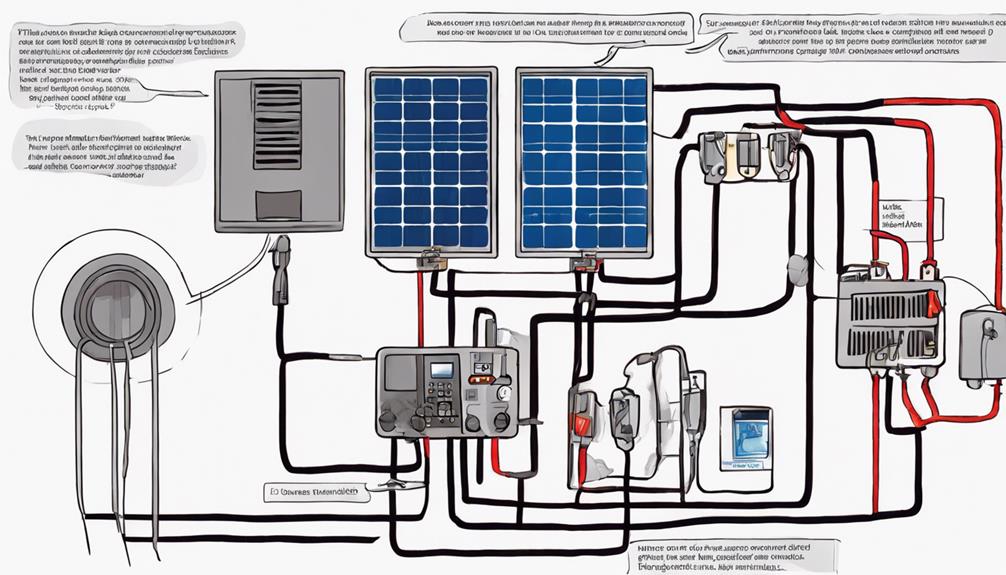
When connecting your inverter to the battery bank, confirm compatibility for efficient energy transfer.
Use proper wiring and connectors to secure the link between the two components.
Make sure to monitor charge levels and configure settings to optimize performance.
Inverter-Battery Bank Connection
Link the inverter to the battery bank to effectively store and utilize the energy harnessed by your wind turbine in the solar system. This connection is essential for managing the flow of electricity and ensuring a stable power supply.
By establishing a secure link between the inverter and the battery bank, you can optimize the storage and distribution of excess energy from renewable sources like wind turbines.
Here are some key points to keep in mind when connecting your inverter to the battery bank:
- Verify proper wiring and secure connections between the inverter and the battery bank.
- Regularly monitor the voltage levels to prevent overcharging or undercharging of the batteries.
- Use appropriate fuses and circuit breakers to protect both the inverter and the battery bank from power surges.
- Take into account the distance and type of cables needed for the connection to minimize energy loss.
- Follow manufacturer's guidelines for the inverter and battery bank to maintain warranty and performance standards.
Hybrid Inverter Selection
To guarantee a smooth integration of your wind turbine with your solar system, selecting a hybrid inverter that's compatible with both energy sources and capable of efficiently managing the battery bank is essential.
When choosing a hybrid inverter, make sure it can effectively link your wind turbine and solar panels while efficiently managing the battery bank. Look for features such as battery state of charge monitoring to optimize performance. Additionally, consider the inverter's ability to handle various battery types for enhanced functionality.
Seeking professional guidance is advisable to help you select the right hybrid inverter for seamless integration.
By carefully evaluating these factors and choosing a hybrid inverter that meets your system's requirements, you can ensure a smooth operation and maximize the benefits of your renewable energy sources.
Controller Compatibility Check
Make certain that the hybrid inverter you select is compatible with both your solar inverter and the battery bank for seamless integration and peak performance.
When connecting a wind turbine to your solar system, controller compatibility is essential for efficient energy management. Here are some key points to keep in mind:
- Check that the controller can handle the combined power input from the wind generators and solar panels.
- Verify that the inverter can effectively manage the charging and discharging of the battery bank to maximize energy storage.
- Confirm that the controller has mechanisms in place to prevent overcharging or undercharging of the battery bank, ensuring its longevity.
- Guarantee proper communication between the inverter and the battery bank for optimal system performance and reliability.
- Prioritize a controller that can coordinate the various energy sources, including wind generators, to provide a stable power output to your battery bank.
Monitoring Battery State of Charge
Monitoring the battery state of charge in your solar system with a wind turbine is vital for efficient energy management. By utilizing a monitoring system, you can guarantee that your battery has sufficient charge to meet the energy demands of your system.
This practice not only allows for the best utilization of renewable energy sources like wind and solar but also helps in preventing overcharging or undercharging, which could negatively impact the battery's lifespan.
Various monitoring systems and devices are available to accurately track and manage the battery state of charge, providing you with real-time data to make informed decisions about your energy usage.
Investing in a reliable monitoring system is essential for maintaining the health and performance of your solar system with a wind turbine, ultimately maximizing the benefits of your renewable energy setup.
Optimizing System Performance
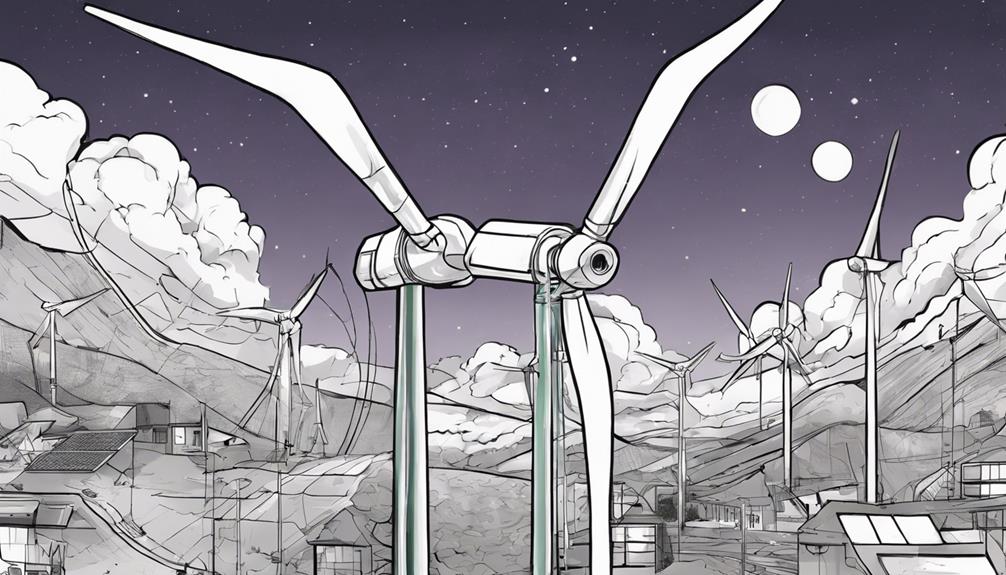
Aligning and spacing your wind turbine and solar panels properly is key to optimizing system performance for efficient energy production. To secure you get the most out of your hybrid wind turbine and solar system, follow these tips:
- Use compatible hybrid inverters and charge controllers to efficiently integrate wind turbine power into the solar system.
- Regularly monitor and adjust system settings to maximize performance and prevent overcharging or undercharging.
- Implement safety measures like manual braking switches for wind turbines to safeguard the system during high wind events.
- Consider the battery type and voltage compatibility when connecting the wind turbine to the existing solar system for seamless integration.
- Opt for a robust and reliable wiring system to handle the combined energy output from the wind turbine and solar panels effectively.
Ensuring Efficient Energy Storage
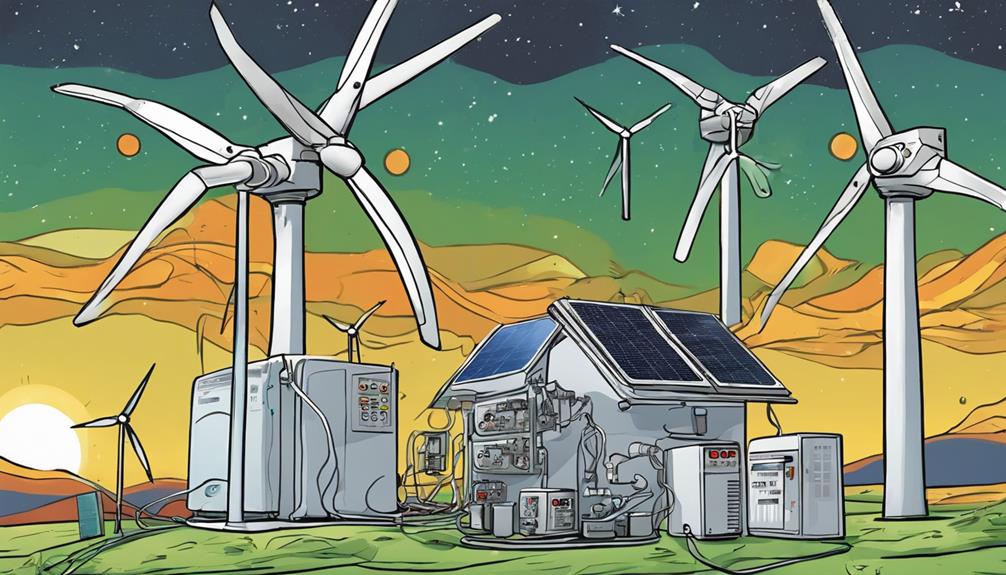
Efficient energy storage is necessary to maximize the benefits of integrating wind turbines with solar systems. Battery banks serve as a primary method for storing surplus energy generated by both sources, allowing for continuous power availability regardless of weather conditions.
Managing energy storage effectively is essential for ensuring a consistent power supply. Charge controllers, an advanced component, play a pivotal role in regulating the energy flow to and from the battery banks, optimizing the overall system performance. These controllers help in preventing overcharging or excessive discharging, thereby prolonging the lifespan of the batteries and enhancing system efficiency.
Maximizing Power Generation

To maximize power generation efficiency in your solar system, consider integrating a wind turbine to supplement energy production during periods of low sunlight. Wind turbines can work in conjunction with solar panels to guarantee a more consistent power supply and increase the overall output of your system.
Here are some key points to help you make the most of your combined wind and solar setup:
- Utilize wind turbines to offset energy production fluctuations in your solar system.
- Ensure compatibility between inverters and controllers for seamless integration.
- Combine wind and solar systems for best power generation in off-grid or hybrid setups.
- Increase renewable energy output by incorporating a wind turbine into your solar system.
- Enhance sustainability by harnessing the power of both wind and solar in your energy production efforts.
Enhancing Overall System Reliability
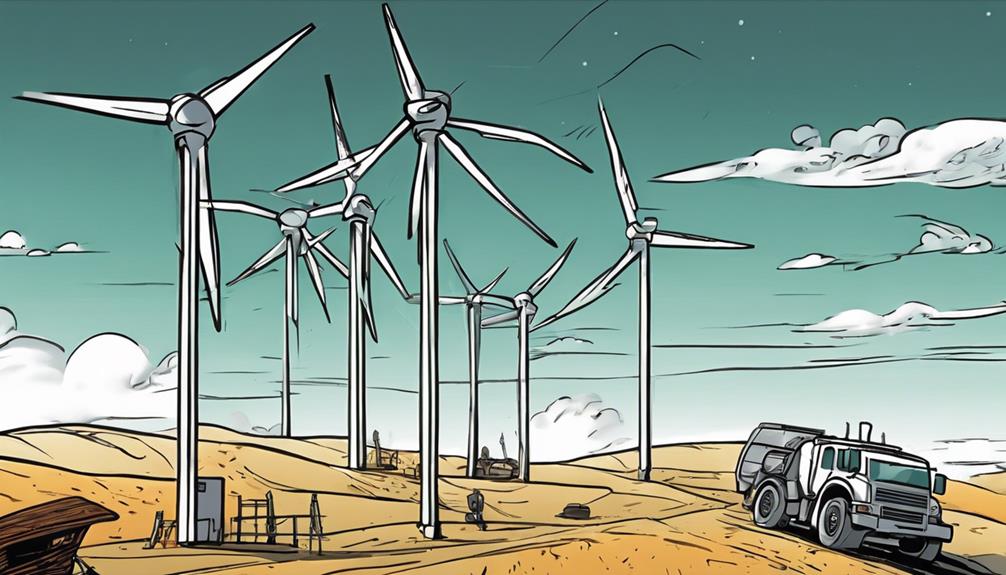
Integrating wind turbines with your solar system greatly boosts overall reliability by providing backup energy during periods of low solar production. By adding a small wind turbine to your setup, you create a more robust energy generation system that can operate effectively even when sunlight is limited.
The DC coupling of wind and solar systems allows for seamless integration, ensuring that the power generated by both sources can be efficiently utilized to meet your energy needs.
Small wind turbines offer a reliable and consistent energy source, complementing the intermittent nature of solar power. This combination not only enhances your system's reliability but also improves overall energy production efficiency.
By diversifying your energy sources, you decrease reliance on a single source, increasing the resilience of your system against fluctuations in weather conditions and energy availability.
Incorporating a wind turbine into your solar system is a strategic choice that can lead to a more stable and dependable energy supply, ultimately providing you with greater peace of mind regarding your power needs.
Frequently Asked Questions
Can I Connect My Wind Turbine to My Solar System?
Yes, you can connect your wind turbine to your solar system. Consider using a hybrid inverter for integration. Confirm compatibility between components. Monitor battery and power usage. Seek professional advice for the right controller for your battery type.
How Do You Combine Wind Turbine and Solar Panel Wiring?
Like merging rivers into a mighty stream, combine wind turbine and solar panel wiring by using a single controller. Simplify setup, guarantee proper sizing, and consider professional help for safety. Create sustainable energy solutions.
How Many Solar Panels Does It Take to Equal a Wind Turbine?
To match the power output of a small wind turbine, you generally need 8-15 solar panels. Factors like panel wattage, turbine size, and local weather affect the exact number. Combining both can optimize energy production.
Do Solar Generators Block Wind Turbines?
Solar generators do not block wind turbines; they can coexist and even enhance each other's energy production. Proper coordination in placement and orientation maximizes efficiency. Integrating both systems boosts overall energy generation and reliability.
Can a Wind Turbine Dump Load Affect the Connection to a Solar System?
Yes, a wind turbine dump load can affect the connection to a solar system. When the wind turbine dump load kicks in, it can disrupt the voltage and frequency on the grid, impacting the stability of the connection to the solar system. Proper integration and coordination are crucial to avoid any issues.
Can Wind Turbines be Integrated into a Solar System to Boost Energy Production?
Yes, wind turbines can be integrated into a solar system to boost energy production. This hybrid system, also known as a wind-solar hybrid, helps to capture clean, renewable energy from both sources. By combining the two technologies, the system can generate more power consistently, which is why wind energy is solar.
Conclusion
Now that you've successfully connected your wind turbine to your solar system, you can enjoy the benefits of increased energy production and efficiency.
Did you know that combining wind and solar power can increase energy production by up to 30% compared to using just one source alone?
Keep monitoring your system and optimizing performance to maximize your renewable energy potential.
Happy generating!
